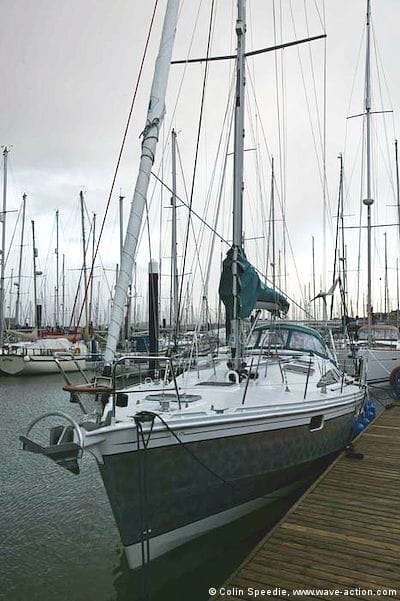Here in Europe the standard rig for most yachts sold as “cruisers” is still the sloop, usually with a large overlapping genoa of 130% or more. That might be fine in sunny sheltered waters with an army of gorillas to help out, but is less than ideal for shorthanded crews sailing in windy and exposed seas.
This is when the ability to shift gear to suit the conditions by reefing swiftly and safely is far more important, and the true cutter rig comes in to its own.
So we have opted for a roller furling yankee, coupled with a hanked on staysail on a detachable stay. The mainsail is fully battened, using Harken cars and mast track—simply the best there is. All reefing will be by single lines lead aft to the cockpit handled by a power driven winch. The aim is to achieve (as far as possible) the ability to reef all sails from the cockpit with the minimum of fuss.

We have specified spare halyards for most sails, believing that the extra complexity and windage should be more than compensated for in terms of safety and reliability. This is not all that awkward to achieve—although our rod kicker (theoretically) does away with the need for a topping lift, we’re still going to have one as it will also double as a spare main halyard. The spinnaker halyard is having an extra long tail, to double up as a lifting halyard for our dinghy, and also so it can be deployed should we have to rescue anyone from the water. As this halyard is led aft to the power winch, this should prove a useful and practical feature.
All OVNIs are supplied with Sparcraft spars, which seem robust and well finished. A full set of folding mast steps are being fitted to simplify regular rig inspections aloft, conning the boat in shallow water and in case of the need to make emergency repairs. As OVNIs are true centreboarders, the mast is mounted well forward above the pivot point of the keel to ensure good balance of the hull and rig. This means that the boom doesn’t sweep the cockpit, a useful safety feature on any cruising boat. For the first time on any of our boats we have specified a boom brake, in our case the new model from Wichard. This is a clever looking device, derived from climbing equipment, and has no moving parts, relying solely on friction to slow the travel of the boom and will double, we are told, as a preventer when fully tensioned. It will be interesting to see how well it works.
The rig is well stayed, in the best traditional cruising manner. Many modern yachts are going over to one single chainplate per side to handle all standing rigging, combined with aft swept spreaders, features that don’t appeal to us on a cruising boat. In contrast, Pèlerin has fore and aft lowers giving vital support where it matters in the bottom panel of the rig, combined with parallel spreaders that reduce chafe on the mainsail, and make it easier to reef the main off the wind—a hardship at times with a fully battened main even with parallel spreaders. Some crews find the running backstays on cutters a nuisance, but we like them as they stiffen the rig up immensely, and are very reassuring in strong winds. Twin standing backstays offer a simple and dependable failsafe in the event of one failing. All in all, it’s a simple, strong, belt and braces set-up in line with our overall philosophy of safe, self-sufficient cruising.

Colin,
We bought our OVNI 435, Ithaka, last year and have sailed her across the Pacific to New Zealand. We intend to head for higher latitudes in the next few years and therefore read your articles with much interest.
We are intending to change out the large and very heavy genoa which came with the boat for a Yankee. Could you provide a little more information on the size and weight of your Yankee? Would you chose the same again? Do you have any other tips on maximising the upwind performance of the 435?
Our single line reefing is not very satisfactory. I find myself going to the mast more often than not either because the low friction blocks have caught some sail or stack pack material, or just because I cannot see what is going on. Could you give some more detail on your system and how it is used?
Did you ever consider a hard dodger for the higher latitudes? Do you find the canvas dodger sufficient?
We have found the 435 a great boat so far. Thanks for the inspiration.
Colin and Ana
S/Y Ithaka
Hi Colin,
I was wondering how you ended up liking the Wichard boombrake ?
I installed the same model on my boat (Atlantis 430, so same kind of boat than yours), and I’m less than happy with it. The strength of the brake is governed by the number of trips you make in the device, and changing it while underway seems downright dangerous to me. In hindsight, I think I would have liked a Walder better, as the brake force is governed by tension and can easily be adjusted from the safety of the cockpit.
In the end, we’re using ours as a preventer more than as a brake …
Brann
Hi Brann,
Colin may not respond. See #3 under comment guidelines.
And I have never used a book brake, so I’m afraid I don’t have anything useful to add. Anyone else have experience?